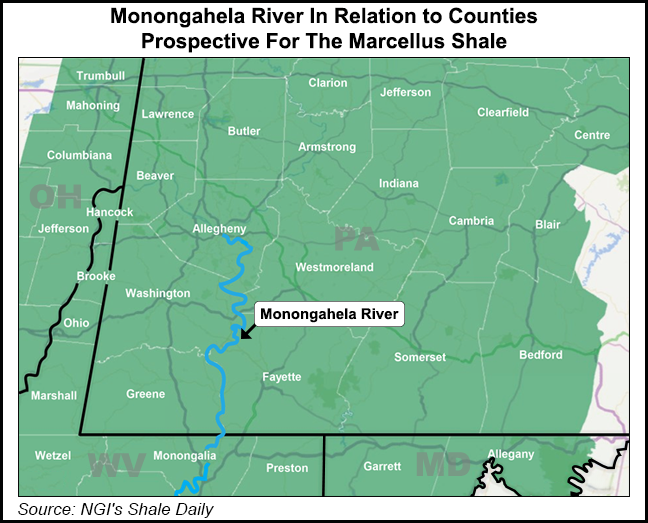Marcellus | E&P | NGI All News Access
Post-Wastewater Discharge Standards, Monongahela River Clean Enough to Drink
A 70-mile stretch of the Monongahela River is no longer impaired for potable water use, according to a report issued by Pennsylvania’s Department of Environmental Protection (DEP). A voluntary prohibition on Marcellus Shale wastewater discharge may get the credit for the cleaner water.

Required every two years by the federal Clean Water Act, the Pennsylvania Integrated Water Quality Monitoring and Assessment Report describes the water quality of the state’s streams, rivers, lakes and waterways. Since the last report, in 2012, a total of 333 miles of previously impaired flowing waters and 853 lake acres were restored, and fish consumption advisories were removed from 11,592 lake acres. The Monongahela, a major river in the western part of the state which was first listed as impaired for drinking water use in 2010, was among those restored in the latest report.
“The Monongahela River, which was impaired for potable water use, was removed from the impairment list because the in-stream level of sulfates now meets Pennsylvania’s water quality standards,” DEP said.
The agency revised wastewater discharge standards in August 2010, requiring natural gas operators to treat wastewater to the federal drinking water standard of less than 500 milligrams per liter (mg/l) of total dissolved solids (see Daily GPI, Nov. 8, 2011; Aug. 26, 2010). The following year, DEP called on the industry to stop sending wastewater to more than a dozen facilities that had been treating it (see Shale Daily, April 20, 2011).
That voluntary measure contributed to the river’s improved water quality, Dave Spotts, chief of the state Fish and Boat Commission’s Division of Environmental Services, told the Pittsburgh Post-Gazette this week. Reductions of mine water discharges and the closure of some coal-burning power plants also helped, Spotts said.
The other major listing change in the most recent DEP report is the addition of “the lower main stem of the Susquehanna River…to the fish consumption impairment list for channel catfish larger than 20 inches due to polychlorinated biphenyls. The recommended consumption rate is no more than one meal per month.”
The U.S. Environmental Protection Agency (EPA) has approved the report, DEP said Monday.
DEP plans to continue and expand its studies of the river and tributaries through 2015. The agency has brought together a panel of experts from Pennsylvania Fish and Boat Commission, Susquehanna River Basin Commission, U.S. Geological Survey, U.S. Fish and Wildlife Service, EPA and members of the Susquehanna River Heartland Coalition for Environmental Studies to gather and evaluate data related to the Susquehanna River and its tributaries for the Causal Analysis/Diagnosis Decision Information System (CADDIS). The CADDIS panel is tasked with determining the attainment status of the Lower Susquehanna and Juniata rivers for the 2016 Integrated Water Quality Monitoring and Assessment.
Earlier this year, DEP said operations at oil and natural gas wells in Pennsylvania harmed water supplies more than 200 times in the seven years between December 2007 and May of this year (see Shale Daily, July 22).
© 2024 Natural Gas Intelligence. All rights reserved.
ISSN © 2577-9877 | ISSN © 2158-8023 |
